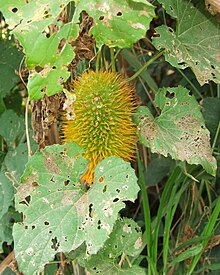Momordica foetida
| Momordica foetida | |
|---|---|

| |
| Scientific classification | |
| Kingdom: | Plantae |
| Clade: | Tracheophytes |
| Clade: | Angiosperms |
| Clade: | Eudicots |
| Clade: | Rosids |
| Order: | Cucurbitales |
| Family: | Cucurbitaceae |
| Genus: | Momordica |
| Species: | M. foetida
|
| Binomial name | |
| Momordica foetida | |
Momordica foetida is a
The plant grows in forest edges and similar habitats (including disturbed and cultivated land), woodland, and wooded grassland. Its leaves are wrinkled, heart-shaped with irregular edges, up to 18 cm wide. The flowers are yellow to yellow-orange. The fruit is a prolate spheroid, 3.5–7.5 cm long and 2.5–5 cm wide, bright orange and covered with soft spines. When fully ripe it splits from the bottom into three valves, exposing a cluster of black seeds, individually covered by a bright red, sticky, sweet pulp. The plant has perennial tuberous roots.
Local names for the plant include concombre sauvage (French for "wild cucumber"), nyanya-nua, sσprσpσ, kakle, awoduan ("snake food"), aoasongo, gaayama, nanïa, n-gessannia, boobo, bobonowron, vovolé, vovoné vono, hepa, ìsúgū, alu-osi, akb’an’udene, ejìnrìn, tsekiri, and a-bos-a-wir.[2]
Uses
Food

The leaves have a bitter taste, but are eaten in
Folk medicine]
Like its relative M. charantia, the plant contains a number of bioactive compounds, including
Digestive disorders
In Tanganika, young leaves are taken for
Pain relief
The leaf sap is used to treat severe
Reproduction
In the Ivory Coast a preparation of the leaves is used as an aphrodisiac and is taken by women as an emmenagogue and as childbirth helper. In Uganda, tea from leaves or roots is used as an abortifacient and an ecbolic.[2]
Skin conditions
In the Ivory Coast, a leaf-decoction is used to treat smallpox. The root is used in Tanganyika to wash small children and mothers' breasts. In South Africa, a root decoction with other plants is taken for boils.[2]
Snake bites
The inflammation caused by the venom of the spitting cobra, (Naja nigrocollis) can be prevented by promptly rubbing the skin with crushed leaves and chewing them. The leaf sap is drunk to treat snakebite.[2]
Other conditions
The leaf sap is used to stop
Other uses

In Malawi, the fruit is used as bait to trap birds. In Gabon, leaves are soaked, dried in the sun, and used to stuff cushions. In Tanganyika, the fruit pulp is believed to be poisonous to
The closest relatives of Momordica foetida can be seen in a molecular phylogeny that includes all species of Momordica.[4]
References
- ^ Jeffrey, C. (1978). "Cucurbitaceae". Flora Zambesiaca. Vol. 4.
- ^ ISBN 094764301X.
- .
- PMID 19686858.
External links
- Dressler, S.; Schmidt, M. & Zizka, G. (2014). "Momordica foetida". African plants – a Photo Guide. Frankfurt/Main: Forschungsinstitut Senckenberg.
